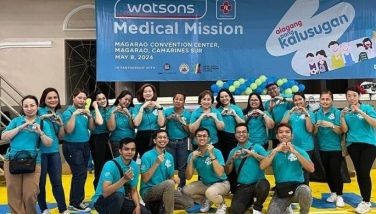Dirty Water
CEBU, Philippines - My plane lands in Manila. Belatedly I realize that I’ve just arrived in “flood country.” I have to dip my newly pedicured feet into dirty, murky floodwater which have remained stagnant for several weeks.
It’s almost a month since Typhoon Ondoy flooded Metro Manila yet floodwaters remain knee-deep in several cities. As I wade in, I notice that the water now has a foul, rotten smell. Like the smell of decay and decomposition.
Waste in water
In a nearby evacuation center, I immediately see that sanitation is a very big problem. People are packed together like sardines. There are not enough facilities for their toilet and bath needs. I have experienced living in public schools in my volunteer work with The Freeman Foundation. I know how difficult it is for 17 people to use a single toilet. How much more if there are 50 or more people. I can just imagine how these toilets are cleaned.
People who were fortunate enough to return home still cannot use their toilets clogged with mud and debris. I see a TV reporter interviewing a flood victim. The reporter asks (in Tagalog): “So where do you throw away your waste?” The flood victim answers rather sheepishly: “Back into the water.” I discover that most of the people defecate into plastic bags and throw it (more like float it) into the floodwater. The very same murky water I’m wading in. I realize that’s why the floodwater smells foul. The very thought is enough to make my skin crawl.
Water shortage is also a big problem. With the limited amount of bottled water donated to these victims, most have to drink straight from the faucet. Water that most probably come from leaking pipes. The same pipes that are submerged in the dirty, bacteria-filled floodwater. The very thought was enough to make me puke.
I can’t switch on the television without news of people getting sick and hospitals overflowing with patients. Many people, especially children, are developing skin diseases like eczema, a flood-borne skin disease characterized by itching and redness.
Aside from eczema and other fungal infections, the Department of Health (DOH) also warns of the rise of water-borne diseases like Acute Diarrhea, Amoebiasis, and Cholera that are transmitted through contaminated food and water. The same contaminated water that the people, most of them in evacuation centers, are drinking. Drinking water that come from the leaking pipes submerged in the floodwater where the people dump their plastic-filled “dump” into. What irony!
Leptospirosis
With the hundreds of people who wade through the dirty floodwater everyday, Leptospirosis is also on a rampage. As of October 12, the Department of Health has recorded 383 cases in nine hospitals in Metro Manila.
Leptospirosis is caused by Leptospira interrogans. Infected rodents and other wild and domestic animals pass the bacteria in their urine into the water or mud. Flooding after heavy rainfall helps spread the bacteria. People get Leptospirosis by swallowing the bacteria from contaminated drinking water or by wading in water contaminated with the Leptospirosis bacteria. Probably the same floodwater I’m wading in.
After washing my legs with about a gallon of alcohol, I crack open my medical books and read that the Leptospirosis bacteria can enter the body through broken skin. (I just had a pedicure and I’m pretty sure the manicurista nicked my skin.)
Once in the bloodstream, the bacteria can reach all parts of the body and can cause fever, headache, nausea and vomiting, eye inflammation, red skin rash and muscle aches. Most people recover after a mild illness of a few days, but some progress into a severe illness over 5 to 7 days. In more severe cases, the illness can result in liver damage and jaundice (yellowing of the skin and whites of the eyes), kidney failure, and internal bleeding.
The medical reference says that if I’m infected then I’d probably have about 5 to 10 days before I start to have a fever. Until then, it is best to see a doctor for a blood test and a prescription of antibiotics.
I wake up with a start and realize that it was just a dream. My flight to Manila is not until tomorrow. Still, to be forwarned is to be forearmed. I think I’d better reschedule my Manila trip until the dirty water there subsides.
For those who absolutely must travel to flooded areas in Metro Manila, here are a few (hopefully) helpful tips:
• Consult your doctor about taking antibiotics before and during travel to help prevent infection from short-term, high-risk exposures.
• Wear protective clothing, such as waterproof boots. Minimize your skin contact with the floodwater which might be contaminated with the dreaded bacteria.
• Wash your hands regularly and sing the “Happy Birthday” song twice. It’s your best line of defense.
• Avoid eating raw vegetables, fruit, and meat that are not properly cooked because it may have been in contact with contaminated water that can cause disease when ingested.
• Lastly, don’t drink tap water. Enough said. For questions, read paragraph 5.
- Latest
- Trending
















